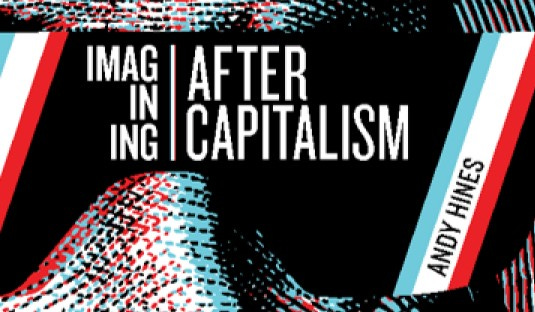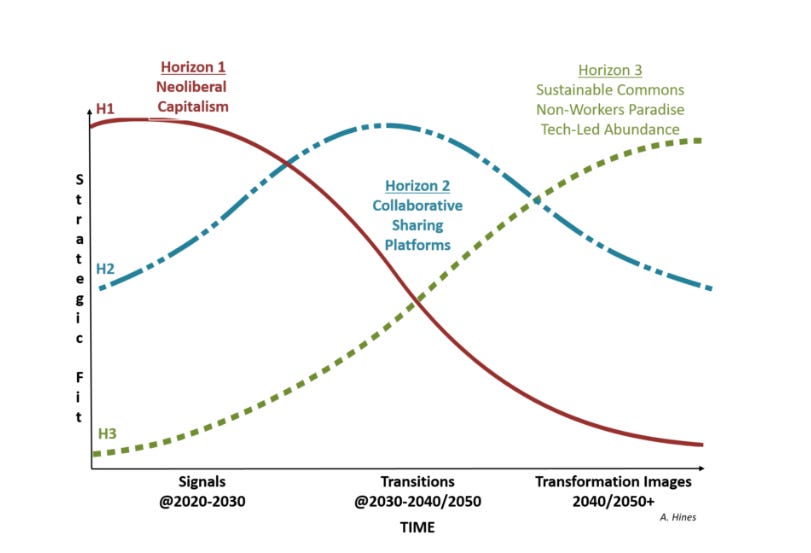Imagining After Capitalism
It ain't that hard ... I found a guide.
People may have an easier time imagining the end of the world, than imagining the end of capitalism. After all, our popular culture provides us with many ways to imagine the end of our civilization. There is a whole movie genre about the end of the world, dystopian future movies including; Mad Max films (some good, some not), Children of Men (great) The Day After Tomorrow (not great), Don’t Look Up (Good when it’s not preachy), Train to Busan (Fantastic), Dawn of the Dead, The Original (First Zombie Movie), Shaun of the Dead (Best Zombie Movie).
But there isn’t much in our popular culture about what comes after capitalism. Maybe that should change. I had the pleasure of chatting with the author of Imagining After Capitalism, Andy Hines after I read his book.
Hines is an Associate Professor and Program Coordinator at the University of Houston Foresight program. He is, for the lack of a better term, a futurist, having spent his career thinking about what comes next - which is the focus of the Foresight Program.
His book tells us that we should start thinking about life after capitalism, because it may be sooner than we think.
According to Hines we have no choice but to develop alternatives, because capitalism is dying.
He says the bad news is that it is going to be long, tough ride for at least the next several years, if not longer, and a “good” future is, by no means guaranteed.
The good news is that there are indeed viable guiding images of life after capitalism.
What does the book say?
I recommend you read the book if you are so inclined because it takes a disciplined and systematic look at how we got here, why here (capitalism) isn’t sustainable, and what might come next. That is the appeal to me of going through Hines’ work. There is a system that he and the folks at Houston Foresight have built to examine these issues. There is no “shooting from the hip” about what one man thinks might happen to capitalism, but an thorough analysis of why capitalism is likely reaching the end of its road, and what might replace it.
Hines cites a Harvard Survey from 2016 that I have cited showing that less than half (45%) of those under the age of 29 then (38 now) support capitalism. When you consider that the median age in the US today is currently 39.1, it is safe to say that about half the country has at best, wavering support for capitalism.
HInes feels that neoliberal capitalism will chug along until there are viable alternatives to galvanize interest on a scale capable of effective action. None of these competing narratives (including degrowth) have an operating system that can challenge capitalism yet, but capitalism isn’t as strong as it looks.
Automation, inequality and climate change and the challenged carrying capacity of Earth are just the most powerful drivers working against capitalism in the long term.
Guiding Images.
Hines puts forth three “guiding images” or aspirational views of the human future based on ideal values within our culture. These are:
Circular commons: Expanding on the concept of sustainability to embrace circular principles as part of a social, political, and economic commons.
Non-workers paradise: A play on the Socialist idea of a “worker’s paradise”, but in the After Capitalism world in which we are not working as much in paid mobs as a means of sustenance.
Tech-led abundance: Technological progress drives and leads to an abundance of wealth that fixes the core distribution problems of capitalism.
If you are wondering when this “After Capitalism” might occur, here is a graphic from Hines’ work that is also in the book.
As you can see, Hines expects that we may begin to move into what comes next in the 2040 - 2050 timeframe, although he cautions that this is just an estimate based on current evidence and that factors can delay or speed up such an eventuality. He also is mindful to state that what comes next won’t happen on a specific date or year, but will slowly evolve as did capitalism itself as it replaced a feudal economic model.
Hines speaks of degrowth and post-growth a great deal in the book, although degrowth is just one of many competing ideas of what will come next. He suggests, that it would be helpful in our transition if we:
-Rethink growth by shifting into a degrowth mode
-Rethink our apartness to an integrated relationship with nature
-Rethink measures of success to focus on wellbeing
Wrapping it up.
Near the end of the book, Hines cites Donella Meadows’ systems intervention framework, where she lists the interventions needed to change a system. The ones she lists first are the easiest to do, but the ones that have the lowest impact (Numbers: subsidies, taxes, standards). The intervention that she sees as having the most leverage is “The mindset or paradigm out of which the goals, rules, feedback structure arise.”
A new paradigm is being built to take the place of capitalism.
I think degrowth is the answer.
What do you think?




I have to disagree with the idea of ‘tech-led abundance’. Technology is what has led us to where we are, probably more significantly than capitalism. More, or even different, mass-produced industrial technologies is not what we need so cheerleading technological innovations is, as Donella Meadows might argue, pushing in the wrong direction.
I do think (mostly influenced by all the things that have been cut with untold damage) that large institutions are too vulnerable to hijacking and not flexible enough to adapt quickly. A bunch of little local groups that can join to act together when needed seems better for many reasons.